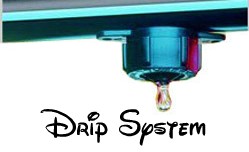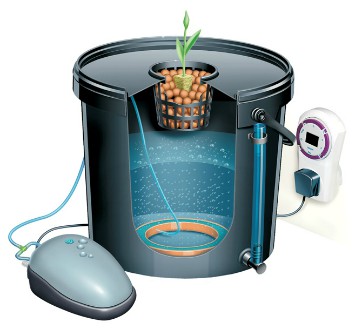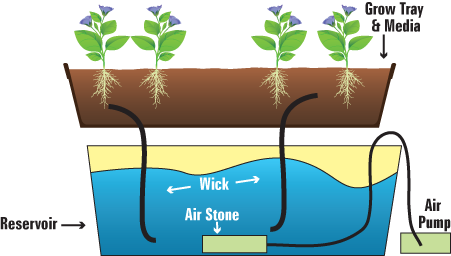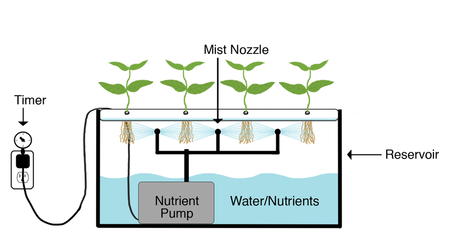Different Types Of Hydroponic Systems
There are 6 main types of hydroponic system. Meanwhile, the plant roots need 3 things, water/moisture, nutrients, and oxygen. So, what differs in the 6 methods is the way the systems deliver these 3 important things to plant roots.
Of course, there are lots of variations with different names but they all boil down to these 6 core types of Hydroponic systems.
Hydroponic systems can be either active or passive. Active means that nutrient solutions will be moved, usually by a pump. Passive relies on a wick or the anchor of the growing media.
Hydroponic systems are also characterized as recovery or non-recovery. Recovery means the nutrient solution will be reused into the system. Meanwhile, with non-recovery, the nutrient solution is applied to the growing media, and vanish.

The ebb and flow system works by temporarily flooding the grow tray with nutrient solution and then draining the solution back into the reservoir. This action is normally done with a submerged pump that is connected to a timer.
When the timer turns the pump on, the nutrient solution is pumped into the grow tray. When the timer shuts the pump off, the nutrient solution flows back into the reservoir. The timer is set to come on several times a day, depending on the size and type of plants, temperature and humidity, and the type of growing medium used.
The ebb and flow method provides a versatile system that can be used with a variety of growing mediums. The entire grow tray can be filled with clay pebbles, gravel or granular Rockwool. Many people like to use individual pots filled with a suitable growing medium. This makes it easier to move plants around or even move them in or out of the system. Plus, the growing medium retains moisture, making plant growth more efficient.

Drip systems are probably the most widely used type of hydroponics system in the world. Operation is simple; firstly a timer controls a submersed pump, then the timer turns the pump on and nutrient solution is dripped onto the base of each plant by a small drip line. In a recovery drip system, the excess nutrient solution that runs off is collected back in the reservoir for re-use. The non-recovery system does not collect the runoff.
A recovery system (recirculating) uses nutrient solutions a little more efficiently. As excess solution is reused, it allows for the use of a more inexpensive timer because the recovery system doesn't require precise control of the watering cycles. The non-recovery system needs to have a more precise timer so that watering cycles can be adjusted to ensure that the plants get enough nutrient solution and that runoff is kept to a minimum. However, a recovery system can cause large shifts in the pH and nutrient strength levels that require periodic checking and adjusting.
The non-recovery system (run off) requires less maintenance because the excess nutrient solution isn't recycled back into the reservoir. In this
system, the nutrient strength and pH of the reservoir will not vary. This means that you can fill the reservoir with pH-adjusted nutrient solution and
then put your feet up until you need to mix.

Deep Water Culture (DWC)
In a DWC system, a plant's roots are suspended in a well-oxygenated solution composed of water and nutrients.
There are three critical parts of this solution:
- Oxygen: Because the roots are submerged in water and not soil (which has gaps and holes where air resides), the water needs to be well oxygenated so the plant doesn't drown. This is accomplished with an air pump and air stone.
- Water: Think of this system as if you're growing in soil and permanently watering your plants - this is one of the reasons growing hydroponically is so beneficial - you never need to 'water' again.
- Nutrients: A good quality soil contains all of the micro and macro nutrients that a plant needs to survive and thrive. Because we have no soil, we need to supplement the oxygen-rich water with nutrients so our plants can grow.
This method is called Deep Water Culture for two reasons. One, you typically grow with a reservoir that can hold a decent amount of water. More water means more stability in your nutrient solution, which means less monitoring and maintenance for you!
The second reason is because of how much of the root mass you submerge in the water. Other methods expose your plant's root zone to air and drench them in water just a few times a day (ebb and flow systems are a good example of this). In deep water culture, most of your plant's root system is submerged 24/7 - hence the name!

Nutrient Film Technique (NFT)
One of the more intricate hydroponic arrangements is known as nutrient film technique (NFT). This also involves the use of a reservoir and pump system. The plants are situated in net pots that allow the root system to hang down, and these pots are aligned in a row down the center of a channel.
The channel resembles a hollow tube with a flat bottom and holes in the top for the plants. The nutrient solution is pumped up from the reservoir to the top of the channel. The channel must be positioned at an angle so that the water flows over the lower tips of the roots and back into the reservoir. The flat bottom on the channel allows for an even layer of solution to cascade over its surface, feeding the root system on the way down.

Wick System
Wick systems work exactly the way you think they do. A pot is connected to a reservoir by a large wick that soaks up the nutrient solution and delivers it to the root system. As the root system absorbs the solution, more is pulled up from the reservoir below. The best media to use in a wick system are cocoa coir or perlite, as they have a high level of absorption and water retention. However, wick systems are more basic than other types of hydroponic systems and they have their drawbacks.
Unlike other mechanisms that deliver water to the root system, the wick method does not always provide enough water to completely saturate the media. So, even though wick systems are simple to use, they are best reserved for small plants or if you have limited space.

Aeroponics
One of the more advanced techniques of hydroponics is called aeroponics. Aeroponics utilizes a net pot and hanging root system like NFT. The roots hang above the nutrient solution reservoir, but the roots and root tips are not submerged. Instead, the nutrient solution is delivered by means of a pump and misting system. These deliver precise amounts of water and nutrients at very specific times to ensure maximum absorption.
The physical design of aeroponic systems can vary, as the upper tray that holds the net pots can be shaped to fit your space. As you really can dial in on the specific needs of your plants, aeroponic systems work extremely well. They are fairly simple in design but can be expensive and tricky to put together, so they are not for a beginner to hydroponics

